Sundial Societies

Sundial societies and sundial registers
This page lists sundial societies in the following countries/regions:
Sundial enthusiasts are organized in different ways. Independent sundial societies are being found in many countries. Elsewhere they may assemble within astronomical or horological societies.
I have listed here only those societies of which I can read the website. Sundials on the Internet has a more extensive listing.
Many societies take care of, or are at least involved in, the cataloguing of sundials in their country. I have included their publications.

The Netherlands
 The Dutch Sundial Society, founded in 1978:
The Dutch Sundial Society, founded in 1978:
- publishes the Bulletin three times per year (ISSN 1383-388X);
- organizes field trips for its members;
- catalogs sundials in the Netherlands;
- gives advice on the design, construction and restoration of sundials.
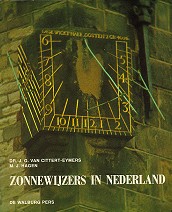 The inventory of Dutch sundials includes presently some 1000 dials. Half of them had been listed already in:
The inventory of Dutch sundials includes presently some 1000 dials. Half of them had been listed already in:
J.G. van Cittert-Eymers & M.J. Hagen, Zonnewijzers in Nederland, Walburg Pers, Zutphen 1984, ISBN 906011-230-X (sold out).
The book has an introductory chapter on the principles and types of sundials. A Supplement was published by the society in January 1999, as an appendix to the Bulletin. An updated, more systematical catalog would be welcomed.
Unfortunately, almost no armillary spheres were included (The Hague, for instance is an exception). Yet many fine specimens can be found, as you can see at here.

Flanders (Belgium)
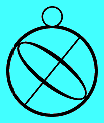 The Flemish Sundial Society has been established in 1995, as a consequence of the successful organization of the Rupelmonde Sundial Trail. The publication Zonnetijdingen has four issues per year.
The Flemish Sundial Society has been established in 1995, as a consequence of the successful organization of the Rupelmonde Sundial Trail. The publication Zonnetijdingen has four issues per year.
The unprecedented Genk Sundial Park has been realized under its patronage.
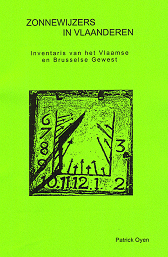 The inventory of sundials in Flanders and Brussels by Patric Oyen saw its fifth edition in 2006, containing some 600 dials. The descriptions are mostly concise.
The inventory of sundials in Flanders and Brussels by Patric Oyen saw its fifth edition in 2006, containing some 600 dials. The descriptions are mostly concise.
I welcome the publication of the inventory on Patric's website (in Dutch). Presently it contains almost 700 sundials, many of them with photos. The inventory is sorted in several ways: according to construction year, by city, province and by type. Worth your visit!

Great Britain
 The British Sundial Society was founded in 1989. It also publishes a Bulletin, which appears three times a year. The BBS keeps a sundial register, which is being published from time to time. The present, third edition dates from 2000 and has many color pictures, according to the BSS website. The website also has a summary of the register. At the end of 2000, almost 4000 dials were recorded, among which 35 analemmatic dials. Only one is found here.
The British Sundial Society was founded in 1989. It also publishes a Bulletin, which appears three times a year. The BBS keeps a sundial register, which is being published from time to time. The present, third edition dates from 2000 and has many color pictures, according to the BSS website. The website also has a summary of the register. At the end of 2000, almost 4000 dials were recorded, among which 35 analemmatic dials. Only one is found here.
The Sundial Glossary, compiled by John Davis, is a most valuable piece of work. A printed version is available.

North America
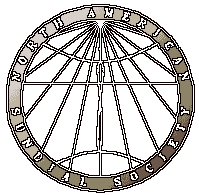 The North American Sundial Society was established in 1994. Its website offers much information, including an extensive links page, arranged by topic. Its sundial registry is among the very few that are available on-line. At the beginning of 2001 the database comprised more than 360 dials, not only in the United States, but also in Canada (about 30) and a few in Mexico and Latin America.
The North American Sundial Society was established in 1994. Its website offers much information, including an extensive links page, arranged by topic. Its sundial registry is among the very few that are available on-line. At the beginning of 2001 the database comprised more than 360 dials, not only in the United States, but also in Canada (about 30) and a few in Mexico and Latin America.
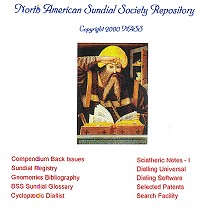 NASS publishes the quarterly Compendium. The Repository is very handy. It is a cd-rom holding all issues of the Compendium published to date (in pdf format), the Sundial Registry, the BSS Sundial Glossary and more.
NASS publishes the quarterly Compendium. The Repository is very handy. It is a cd-rom holding all issues of the Compendium published to date (in pdf format), the Sundial Registry, the BSS Sundial Glossary and more.

Germany
 The German sundial friends gather in the Sundial Workgroup of the German Society for Chronometry (Deutsche Gesellschaft für Chronometrie, DGC) (websites in German). The workgroup was established in 1971 and is the oldest sundial organization around, I think. Articles are published in the DGC Mitteilungen, which are also available on-line.
The German sundial friends gather in the Sundial Workgroup of the German Society for Chronometry (Deutsche Gesellschaft für Chronometrie, DGC) (websites in German). The workgroup was established in 1971 and is the oldest sundial organization around, I think. Articles are published in the DGC Mitteilungen, which are also available on-line.
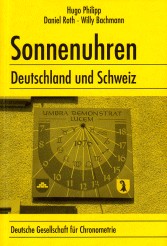 An impressive publication is the catalog of German and Swiss sundials by Hugo Philipp, Daniel Roth and Willy Bachmann, Sonnenuhren Deutschland und Schweiz, Deutsche Gesellschaft für Chronometrie, 1994, ISBN 3-923-422-12-1 (in German). It lists data on some 8000 dials in a systematic fashion. Very well done! The objects have been arranged according to the postal city code, which makes it less easy for tourists to use as a travel guide.
An impressive publication is the catalog of German and Swiss sundials by Hugo Philipp, Daniel Roth and Willy Bachmann, Sonnenuhren Deutschland und Schweiz, Deutsche Gesellschaft für Chronometrie, 1994, ISBN 3-923-422-12-1 (in German). It lists data on some 8000 dials in a systematic fashion. Very well done! The objects have been arranged according to the postal city code, which makes it less easy for tourists to use as a travel guide.
Daniel Roth also maintains an extensive list of sundial links. In addition, he hosts the Sundial Mailing List, a sometimes lively discussion group (see the links page).

Austria
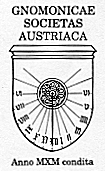 The Austrian organization is the Sundial Workgroup of the Austrian Astronomical Society, founded in 1990. It is most easily reached through the homepage of Karl Schwarzinger. In addition, this route enables you to enjoy his collection of sundial pictures, adequately commented in German and English.
The Austrian organization is the Sundial Workgroup of the Austrian Astronomical Society, founded in 1990. It is most easily reached through the homepage of Karl Schwarzinger. In addition, this route enables you to enjoy his collection of sundial pictures, adequately commented in German and English.
The bulletin Rundschreiben appears twice a year.
The Austrian sundial catalog (2nd edition, 1993) has been sold out. The third edition, based on the ca. 3000 dials in the database, is being planned.

France
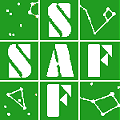 Here, too, one has found lodging with the astronomers: the Sundial Committee of the French Astronomical Society dates from 1972. Papers are mostly published in L'Astronomie, the society's journal.
Here, too, one has found lodging with the astronomers: the Sundial Committee of the French Astronomical Society dates from 1972. Papers are mostly published in L'Astronomie, the society's journal.
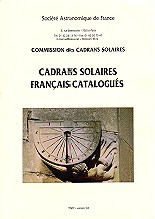 The French sundial catalog is the most extensive I know: it holds 10,000 dials (according to the preface, I didn't check). The present edition is the third one, from ca. 1998. The objects have been arranged by département, and then by locality. Schematic maps at the back provide a little orientation. The descriptions are mostly brief and not very systematic. Some 40 analemmatic sundials should be listed, but I haven't discovered most of them yet...
The French sundial catalog is the most extensive I know: it holds 10,000 dials (according to the preface, I didn't check). The present edition is the third one, from ca. 1998. The objects have been arranged by département, and then by locality. Schematic maps at the back provide a little orientation. The descriptions are mostly brief and not very systematic. Some 40 analemmatic sundials should be listed, but I haven't discovered most of them yet...
The pages tend to come loose, but that may be an advantage when on a holiday trip...
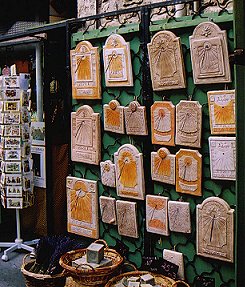
The catalog also tries to keep track of the 'souvenir dials'; une mer à boire !

Quebec (Canada)
The Quebec Sundial Committee has been established in 1994, after the French example. Yet, it is not part of a larger organization. What I like is that its bulletin, Le Gnomoniste, is published on the website in its entirety. Although this may not help in increasing the (paying) membership!

 The Dutch Sundial Society, founded in 1978:
The Dutch Sundial Society, founded in 1978: The inventory of Dutch sundials includes presently some 1000 dials. Half of them had been listed already in:
The inventory of Dutch sundials includes presently some 1000 dials. Half of them had been listed already in: The
The  The inventory of sundials in Flanders and Brussels by Patric Oyen saw its fifth edition in 2006, containing some 600 dials. The descriptions are mostly concise.
The inventory of sundials in Flanders and Brussels by Patric Oyen saw its fifth edition in 2006, containing some 600 dials. The descriptions are mostly concise. The
The  The
The  NASS publishes the quarterly Compendium. The Repository is very handy. It is a cd-rom holding all issues of the Compendium published to date (in pdf format), the Sundial Registry, the BSS Sundial Glossary and more.
NASS publishes the quarterly Compendium. The Repository is very handy. It is a cd-rom holding all issues of the Compendium published to date (in pdf format), the Sundial Registry, the BSS Sundial Glossary and more. The German sundial friends gather in the
The German sundial friends gather in the  An impressive publication is the catalog of German and Swiss sundials by Hugo Philipp, Daniel Roth and Willy Bachmann, Sonnenuhren Deutschland und Schweiz, Deutsche Gesellschaft für Chronometrie, 1994, ISBN 3-923-422-12-1 (in German). It lists data on some 8000 dials in a systematic fashion. Very well done! The objects have been arranged according to the postal city code, which makes it less easy for tourists to use as a travel guide.
An impressive publication is the catalog of German and Swiss sundials by Hugo Philipp, Daniel Roth and Willy Bachmann, Sonnenuhren Deutschland und Schweiz, Deutsche Gesellschaft für Chronometrie, 1994, ISBN 3-923-422-12-1 (in German). It lists data on some 8000 dials in a systematic fashion. Very well done! The objects have been arranged according to the postal city code, which makes it less easy for tourists to use as a travel guide. The Austrian organization is the Sundial Workgroup of the
The Austrian organization is the Sundial Workgroup of the  Here, too, one has found lodging with the astronomers: the
Here, too, one has found lodging with the astronomers: the  The French sundial catalog is the most extensive I know: it holds 10,000 dials (according to the preface, I didn't check). The present edition is the third one, from ca. 1998. The objects have been arranged by département, and then by locality. Schematic maps at the back provide a little orientation. The descriptions are mostly brief and not very systematic. Some 40 analemmatic sundials should be listed, but I haven't discovered most of them yet...
The French sundial catalog is the most extensive I know: it holds 10,000 dials (according to the preface, I didn't check). The present edition is the third one, from ca. 1998. The objects have been arranged by département, and then by locality. Schematic maps at the back provide a little orientation. The descriptions are mostly brief and not very systematic. Some 40 analemmatic sundials should be listed, but I haven't discovered most of them yet...